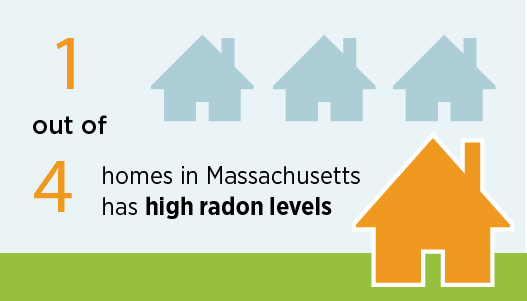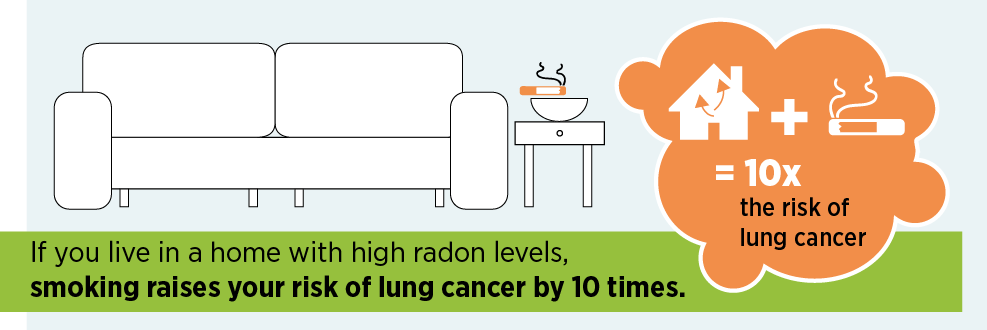What is radon and why is it dangerous?
Radon is a radioactive gas that comes naturally from soil and rocks. Radon can move from the ground into your home through cracks and holes in the foundation. It can also enter a home through private well water.
Radon can build up inside your house and cause lung cancer if you breathe it in over many years. Radon is the #1 cause of lung cancer among people who don’t smoke. Lung cancer risk is much higher for people who are exposed to radon and smoke.
Where is radon a problem?
No area of Massachusetts is free of risk. You can’t see, taste, or smell radon. Testing your home is the only way to know if radon is a problem. Any home can have high levels of radon—new and old homes, well-sealed and drafty homes, and homes with or without basements. Even two homes right next to each other can have very different radon levels.
How do I test my home?
To test your home for radon. You can buy a radon test kit from a home improvement store or hire a certified radon measurement specialist. Visit www.mass.gov/radon to see the fact sheet “Testing Your Home for Radon” to learn more.
Winter is the best time to test your home because windows and doors are closed and the heating system is on. If you test the home in the summer and get a low number, test again in winter. Radon levels can change with the season. If the home already has a radon mitigation system in place, it is important to test whether or not the system is working and reducing radon levels.
What do my test results mean?
Radon test results are reported in picocuries per liter of air or pCi/L. The U.S. Environmental Protection Agency (EPA) set an “action level” for radon at 4 pCi/L. You should fix (“mitigate”) your home if radon is above the action level. No radon level is risk-free. The EPA recommends that you consider action if your home’s radon level is between 2 and 4 pCi/L.
What should I do if I am renting a home?
If you rent, ask your landlord to test for radon. If your landlord doesn’t test, you can test yourself. It is easy to do and takes very little time. Read “Testing Your Home for Radon” on www.mass.gov/radon for more information.
What should I do if I am buying a home?
Do not assume the mitigation system has fixed the problem. Try to get the original radon test from the seller of the house. If the radon level was very high (> 100 pCi/L [picocuries per liter of air]), additional safeguards may be needed. Call the MA Radon Hotline for information and see the “Fixing Radon in Your Home” fact sheet.
For houses built after 2014 in U.S. EPA Zone 1 Radon Areas — One and two family dwellings in Essex, Middle- sex, and Worcester counties built after January 2, 2015 must have a passive (not fan-powered) radon mitigation system. Find out if the house meets the requirements in Appendix F of the Massachusetts Residential Code and its amendments (set 1 and set 2). Builders are not required to test for radon. Even if a house has a passive radon mitigation system, test it before purchase. Hire a certified mitigation specialist if you have a radon test result of 4 pCi/L or more.
What if radon in my home is above the action level?
Fixing a radon problem involves repairs to the building. A “certified mitigation specialist” should be called to install a system that fixes the problem. For more information on fixing radon in your home, visit www.mass.gov/radon.
If you rent, usually the building owner, not the tenant, makes these repairs. You can take some steps to get the problem fixed:
- Tell the building owner in writing about your test results. Ask what steps the owner will take to fix the problem.
- If you live in an apartment building, you can share your radon information with other residents. Your neighbors might want to test their own units or discuss the issue with the owner.
What are some ways to protect my and my family from radon?
Testing for radon is the only way to protect you and your family. However, consider these steps if you don’t have information about radon in the home. These actions may reduce how much radon you breathe in:
- Limit time spent in the basement. Put sleeping areas and children’s play areas in the highest levels of the home.
- Consider renting a second-story unit when you are looking for a new home. Rent a basement or first-story unit only if the landlord can show you radon levels are below the action level.
- If possible, avoid continuous use of exhaust fans in bathrooms and kitchens.
- When you are not using the fireplace, shut the chimney damper.
- If you smoke, step outside to smoke.
To learn more about radon, visit www.mass.gov/radon. If you have questions, contact the Massachusetts Radon Hotline at (800) 723-6695.
Additional Resources
-
Open PDF file, 1017.53 KB, Radon in the Homes (English, PDF 1017.53 KB)
Contact
Online
Phone
or
The operating hours are Mondays through Fridays from 8:45 a.m.-5 p.m. Please leave a message including your phone number and you will receive a call back.


